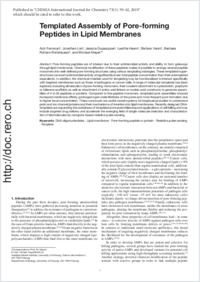Templated assembly of pore-forming peptides in lipid membranes
- Fennouri, Aziz Adolphe Merkle Institute, University of Fribourg, Switzerland
- List, Jonathan Adolphe Merkle Institute, University of Fribourg, Switzerland
- Dupasquier, Jessica Adolphe Merkle Institute, University of Fribourg, Switzerland
- Haeni, Laetitia Adolphe Merkle Institute, University of Fribourg, Switzerland
- Vanni, Stefano Department of Biology, University of Fribourg, Switzerland
- Rothen-Rutishauser, Barbara Adolphe Merkle Institute, University of Fribourg, Switzerland
- Mayer, Michael Adolphe Merkle Institute, University of Fribourg, Switzerland
-
27.02.2019
Published in:
- CHIMIA International Journal for Chemistry. - 2019, vol. 73, no. 1, p. 59–62
English
Pore-forming peptides are of interest due to their antimicrobial activity and ability to form gateways through lipid membranes. Chemical modification of these peptides makes it possible to arrange several peptide monomers into well-defined pore-forming structures using various templating strategies. These templated super-structures can exert antimicrobial activity at significantly lower total peptide concentration than their untemplated equivalents. In addition, the chemical moieties used for templating may be functionalized to interact specifically with targeted membranes such as those of pathogens or cancer cells. A range of molecular templates has been explored, including dimerization of pore-forming monomers, their covalent attachment to cyclodextrin, porphyrin or fullerene scaffolds as well as attachment of amino acid linkers or nucleic acid constructs to generate assemblies of 4 to 26 peptides or proteins. Compared to free peptide monomers, templated pore assemblies showed increased membrane affinity, prolonged open-state lifetimes of the pores and more frequent pore formation due to higher local concentration. These constructs are useful model systems for biophysical studies to understand porin and ion channel proteins and their mechanisms of insertion into lipid membranes. Recently designed DNA- templates are expanding the usefulness of templated pore assemblies beyond applications of cell killing and may include targeted drug delivery and accelerate the emerging field of single-molecule detection and characterization of biomolecules by nanopore-based resistive pulse sensing.
- Faculty
- Faculté des sciences et de médecine
- Department
- Département de Biologie, AMI - Biophysique, AMI - Bio-Nanomatériaux
- Language
-
- English
- Classification
- Biological sciences
- License
-
License undefined
- Identifiers
-
- RERO DOC 324638
- DOI 10.2533/chimia.2019.59
- Persistent URL
- https://folia.unifr.ch/unifr/documents/307864
Statistics
Document views: 147
File downloads:
- pdf: 170
